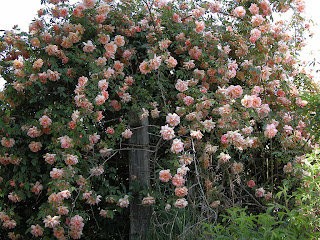Apart from the very passionate and serious gardeners among us who spend good deal of their time searching for rare pearls in the vast kingdom of Botany, most amateur gardeners relay on the plant offers most next door nurseries propose.
Let's be frank - most of the time, the choice is pretty dull and restraint to arch-known plants ( a couple of badly labelled modern roses, fire engine red geraniums, some pinks and petunias and some more herbs) as if the average gardener would be deadly scared of venturing himself on new grounds.
Deadly sin (in the botanical sense of course) since the plant world is literally full of great plants which deserve to be better known and of course planted in our gardens.
More to the point, little known does not rime with difficult to grow or delicate - quite a lot of them are sturdy and healthy growing types which will fill you with satisfaction if you allow them into your vegetal kingdom.
Today I would like to talk about the Fremontodentrum Californicum.
The fremontowhat? most of you (Californian among you are obviously excluded) will be likely to ask...
Well call it Flannelbush or Fremontia if this makes you more comfortable.
We are talking about a small tree from California, which is a real treasure! And now I will tell you why.
A moderate grower, the Flannelbush reaches 6 m on average, which makes it suitable even for small plots, and planting next to walls or fences. As you can see it litterally covers itself with 5-6 cm big waxy flowers of the purest gold yellow during the summer. The blooming period is reasonably long and attracts bees.
The leaves are tiny and somewhat coarse, medium shiny and dark green on the upper side and covered by a brownish hair on the backside. In mild climates it is almost an evergreen. The flower buds and seed pods, which are produced in abundance, are as well hairy. Though the plant is not toxic, it is recommended to wear gloves if manipulating it, since the hairs can result skin irritating.
The Fremontodendron is supposed to be hardy up to -10 Cº but I would rather give it a sheltered place and assure some winter protection especially during the first years in areas which are not mild.
And now comes the real bonus: the Flannelbush requires virtually no cares once you plant it in a sunny spot. It loves poor, stony soils and does not care for being fertilised, watered or sprayed or whatsoever. It just grows by its own, as any wild tree would do! Isn't that good news? A plant that flowers so lavishly and which is not supposed to be delicate!
What makes it even more interesting especially in the Mediterranean zone is its low water requirements and the fact that it is quite fire resistant! Actually it makes a really interesting plant for the urban areas since it is so little demanding and of moderate size. The first time I saw it actually was in a tiny park in the South of France and it made quite a show!
Finding the Flannelbush in local nurseries can reveal a bit tricky, but no determined gardener will desist from scanning tons of catalogues in order to get his hands on, once he fell under the spell, right? Otherwise you can try growing it from seed ( not quite simple, since you have to refrigerate the seeds, and then drench them in hot water before seeding... or otherwise try to root some cuttings). So keep your eyes open if you see it while you're on vacation.*
PS. * this is not meant as an invitation to devastate public parcs, but as the great landscape designer Gilles Clement said, a man should behave like a bird and spread plants by taking seeds... after all this is the reason plants do produce seeds!






















